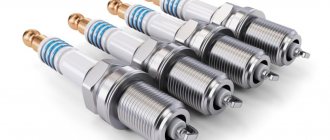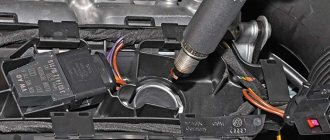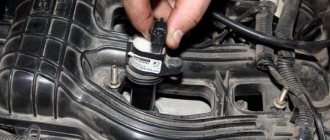The question often arises - after how long and how often do you need to change spark plugs? In general, among car owners and auto repairmen, there are different opinions about the timing of replacing a spark plug. And as you understand, there is no definite answer, everything is strictly individual.
Some spark plugs last for 10,000 km, others bring this figure to 100,000; you must agree, the range is great. But nevertheless, you need to try to understand the topic
and understand what determines the service life of this engine component.
After how long and how often you need to change spark plugs depends, first of all, on the spark plugs themselves, their quality, and manufacturer. In the auto parts market, spark plugs are divided into regular and platinum or iridium.
Due to their design features, spark plugs are located inside the engine and it is impossible to understand how bad the wear of an individual spark plug is without removing it. This imposes some difficulties, but nevertheless, there is an option to determine the service life of the spark plug - listen to the opinion of the car manufacturer, and you can find out the details in the car’s instructions.
Scheduled vehicle maintenance is usually carried out at 10,000-15,000 km, so it is recommended to change them every time you pass this mark. Since automakers assume that the car owner will use only original spark plugs in his car (these most often include the platinum or iridium type), then for regular spark plugs this figure should be reduced.
Alternatively, after a long run, for example, 15,000 km.
It is recommended to unscrew the spark plugs and check them for wear. But again, everything is individual and depends on many factors.
To one of the reasons
The reason why spark plugs quickly fail can be attributed to the use of a low-quality fuel mixture. Yes, it’s no secret that gas stations (especially those of unknown origin) operate in difficult competitive conditions and they physically cannot be competitive. This forces the use of multiple additives, resins, etc. which reduce the cost of obtaining fuel. And this negatively affects the performance of engines.
As you understand, there is only one piece of advice - refuel at stations that are represented by reputable fuel suppliers and always keep your receipt.
The first thing that catches your eye when the spark plugs are worn out is that the engine starts to stall. Extraneous, uncharacteristic vibrations and noises appear, and the speed is unstable. Before turning to specialists and spending your hard-earned money on it, you can try to visually assess the condition of the candles yourself.
Next you need to determine the electrode gap
, its size and soot level. To understand the size of the gap, you can read the instructions for the specific brand of spark plugs, there you will find the permissible values and values indicating that the spark plugs need to be replaced. A larger gap than necessary means the spark plug has traveled a sufficient number of km. mileage and requires replacement.
Regarding carbon deposits, ideally there should not be any, if it is present, then fuel combustion does not occur as it should. Also pay attention to the condition of the ceramic insulators. They must be intact, without any defects or cracks.
How often should spark plugs be changed? Assessing the condition of the spark plugs
Many people want to know about spark plugs and how often to change them.
This is very important, since the performance of the power unit and driving pleasure depend on it. Many experts and ordinary motorists have different opinions about the timing of replacing spark plugs, and this is not surprising. After all, not everyone reads the special documents that come with the car. The result is unpleasant situations. To prevent this, you should go to the manufacturer’s website and download the necessary documentation. It is worth noting that some spark plugs can last 10 thousand kilometers, while others can last 100 thousand. All this depends not only on the quality of workmanship, but also on service. After all, if the driver regularly cleans them and changes all special fluids, then there will be no problems. Spark plugs, how often to change them - this question worries many drivers. In addition, I would like to understand how to change spark plugs correctly, if necessary. It is worth noting that the process is not very difficult, anyone can do it. The main thing is to do everything carefully and slowly. The replacement period depends, first of all, on the manufacturer itself and the quality of the work. After all, if everything is done poorly, then the product will not last long. Currently, there are not only ordinary spark plugs, but also platinum and iridium spark plugs. All of them differ not only in cost, but also in service life.
Every driver knows that spark plugs are located directly in the car engine. To find out the wear of a part, it must be removed. There is no way without this. It is recommended to listen to the opinion of the car manufacturer and buy those spark plugs that suit your car. If you install others, some troubles will arise; this should always be remembered.
Everyone knows that maintenance is done every 10 thousand kilometers. In fact, this is a planned event that should not be missed. During its passage, you can change the spark plugs so that the power unit operates stably and without extraneous noise. Many manufacturers say the mark is slightly lower to warn drivers against possible unforeseen events. After all, it is not always possible to perform maintenance on time. It is recommended to change spark plugs after the 15 thousand kilometer mark. You should unscrew all the spark plugs and carefully inspect for wear.
The main reason for spark plug failure is the filling of low-quality fuel. Everyone knows that different fuels are currently sold that do not meet all standards. Because of this, serious problems arise with the power unit. It's no secret that there is serious competition in this area. Everyone wants to get more clients, and, accordingly, profit. We have to use all sorts of methods to dilute the fuel and so on. No one pays attention to quality, since the main thing is to sell. In modern fuel you can find not only additives, but also unpleasant impurities. This whole thing settles on the spark plugs, thereby worsening the work. Experts recommend refueling only at trusted gas stations where all the necessary documents are available. After refueling, be sure to keep your receipt.
When the spark plugs wear out, the engine begins to stall, operate unstably, and extraneous sounds and noises appear. All this negatively affects technical data and dynamics. The first step is to check the general condition of the spark plugs. Perhaps everything can be fixed on the spot, without contacting service.
After this procedure, the electrode gap, amount of carbon deposits and size are checked. As for the size itself, you can find out such information in the instructions that come with the brand of candles. If a large gap is detected, it means that the spark plugs have already traveled a sufficient number of kilometers and require replacement. If you close your eyes to this, then in the future the engine will no longer work correctly. As for soot, there shouldn’t be any at all. But if there is a small amount, then it’s okay. It is recommended to clean the spark plug and continue using it. If mechanical damage is detected, the spark plug is thrown out and a new one is installed. There's nothing you can do about it.
This is interesting: Selection of Kayaba shock absorbers by car
So we found out when to change spark plugs and how long they can last. When replacing, you should do everything according to the instructions, buy only those candles recommended by the manufacturer. Otherwise problems will arise. Spark plugs, how often should they be changed? This question comes up quite often. The answer to this can be found by reading the article. Every driver, even a novice, can change spark plugs. There is nothing complicated about this, the main thing is to do everything efficiently and accurately.
The importance of correct spark plug installation
The consumable element in question is often rendered unusable by its incorrect installation. The tightening torque of the candles plays a big role here. For each of them, the required moment is indicated on the packaging, but not everyone pays attention to it, and if they do, they consider this parameter to be of little significance. Therefore, not all motorists have a torque wrench - you can tighten it by hand to a certain angle. Practice shows that the torque with seemingly the same tightening force can differ by tens of N*m.
A smaller torque cannot provide the required level of tightness and fastening reliability. High, on the contrary, leads to disruption of the thermal characteristics of the candle and damage to the threaded part. Recommendations for tightening the spark plugs to a certain angle largely only prevent their incorrect operation, but this method is by no means correct, so it is important not only to know at what mileage to change the spark plugs, but also to install them correctly.
Why change spark plugs if the old ones still work?
by wpadm May 21, 2016
It happens that you come to a car service center to change the engine oil, and in addition to this, the mechanic tells you:
“comrade, it’s time for you to change the spark plugs . And in response, your face stretches out in surprise, and you ask him in turn: “Why change the spark plugs if the old ones work?” .
Let's figure it out - it's time to throw away the old spark plugs or the car will still run just fine on them. To begin with, let's decide on the question - why does an engine need spark plugs , is it really possible without them? Let’s just say that without them the car simply won’t go anywhere, and if it does go, it will only be in a tow or tow truck, that is, not under its own power. According to the book, they are needed to use the spark that appears between the electrodes of the spark plug to ignite the fuel-air mixture in the engine cylinders. Moreover, each cylinder has its own spark plug.
In the future, you need to understand the design of any spark plug. So, a spark plug consists of:
- contact pin;
- insulator;
- insulator ribs;
- central electrode;
- side electrode;
- seal.
Each of these elements performs its own function: the high-voltage wire of the ignition system is connected to the contact terminal; the insulator protects the spark plug from overheating; the ribs of the insulator will not allow electrical breakdown along the surface of the insulator; the seal will not allow hot gases to escape from the combustion chamber; Well, it is between the central and side electrodes that the spark of interest to us arises.
So, depending on the gap between the central and side electrodes, ignition of the mixture will occur more or less effectively. The larger the gap, the more powerful the spark and the larger the ignition area, the combustion of fuel is more efficient; therefore, fuel consumption will be stable and engine operation will be smoother. If the gap in the spark plugs is small, then the spark will appear earlier, the spark energy will be less, the mixture will burn worse and the engine performance will deteriorate.
Geometric parameters
Spark plugs can have different geometric parameters:
- Thread diameter - 10, 12, 14 or 18 mm.
- The threaded part - the candle skirt - is of different lengths.
- Different spark gap - 0.9-1.1 mm.
- The body shape is cylindrical or conical. A spark plug with a cylindrical body will have a sealing washer; in the case of a conical body, a washer is not needed.
Geometric parameters depend on the design features of a particular engine - they must be exactly as required by the manufacturer. If instead of the required spark plug you install an “almost the same” but slightly different one, at best the engine will not work normally, at worst - expect trouble.
For example, if the spark plug has too short a thread, the electrodes will be located much higher than necessary, which means the spark will not form where it is needed. Misfire will occur and the engine will lose traction. It will also begin to shake, and fuel consumption will increase: a significant part of it will not burn and will fly away into the atmosphere.
If the thread is too long, there are two options:
- the spark plug will overheat and glow ignition will occur;
- the spark plug will simply hit the piston and you will either have to do a major overhaul of the engine or buy a contract one.
What types of spark plugs are there?
Among themselves, car enthusiasts divide spark plugs into:
They are called so based on the materials used in the production of electrodes. In classic spark plugs, the electrodes are made of copper, in platinum spark plugs, from platinum, and in iridium spark plugs, they are made of a special iridium alloy. Some manufacturers have classic spark plugs with copper electrodes; for “better quality” they are coated with yttrium alloy, which increases the stability of the electrodes.
Platinum is highly resistant to corrosion and can withstand high temperatures well, which significantly increases their service life. Iridium spark plugs are similar in their characteristics to platinum spark plugs. Meanwhile, the longest service life is for spark plugs whose electrodes are made from a platinum-iridium alloy.
Center electrode material
One of the goals that engineers have when choosing a metal for electrodes is to slow down their wear. A spark is a stream of charged particles - electrons and ions. They move at great speed in the electric field between the electrodes, and when they meet their surface, they knock out metal atoms from them. The electrodes gradually lose substance and “burn out,” but this process can occur in different ways: it all depends on the alloys and metals at the ends of the electrodes. Manufacturers' catalogs contain mainly nickel, iridium, platinum and, less often, silver spark plugs.
Nickel is used to make budget spark plugs. It is inexpensive, easy to mass produce, and relatively refractory. On average, nickel spark plugs last up to 40,000 km without interruption. They are used in engines with a volume of up to 1.6 liters with a low compression ratio, which run on AI-92 or AI-95 gasoline.
Silver has high thermal conductivity and can operate over a wide temperature range. Therefore, spark plugs with a silver central electrode are used in engines that run on gas and sometimes gasoline. Service life - up to 50,000 km.
Nickel spark plugs have a fairly thick central electrode - approximately 2.5 mm in diameter. It is mainly composed of an alloy of nickel and chromium. Silver electrode - slightly thinner, approximately 2 mm in diameter, consists primarily of silver.
What is the lifespan of spark plugs?
There is no clearly defined service life for this or that type of candle; manufacturers link this to many factors that objectively affect the service life. For example, this is the material from which the spark plug electrodes are made, operating conditions, such as climatic conditions, fuel quality and many other parameters.
For example, ordinary classic spark plugs will last no more than 50 thousand kilometers on average. Platinum and iridium - approximately 90 thousand kilometers (almost twice as much as classic ones). Naturally, these figures are approximate and are directly dependent on what kind of gasoline is poured into the gas tank and the technical condition of the engine. Therefore, car manufacturers advise replacing classic spark plugs at every second scheduled maintenance (first 30, then 60 thousand km). Platinum or iridium spark plugs will travel one and a half to two times longer.
Essence of the operation
The same applies to the operation of replacing spark plugs in a car, we will first consider it on a relatively popular Japanese car with a complex organization of the engine compartment.
So, we will describe in the following lines how parts are changed for a Subaru Forester car. For this procedure you will need to prepare the following:
- spark plug wrench with ratchet drive and extension;
- compressor.
- We dismantle the air filter housing and the windshield washer reservoir.
- On the first cylinder, pull out the high-voltage wire, holding the tip.
- We blow out the spark plug well with air from the compressor.
- Insert the spark plug wrench and unscrew the old part.
- We evaluate the condition of the old part, the degree of soot, ash deposits or oil traces (we'll talk about this later) by pressing the new part onto the threads in the socket with your hand, screw it in with a wrench, then insert the wire until it stops.
- Repeat the last three steps for the remaining three cylinders.
- Reinstall the air filter housing and windshield washer reservoir.
In other cars, replacing spark plugs is done in a similar way, the main thing is to first remove anything that prevents you from getting to the wells, and also blow out dust from the wells.
Let's see, for example, how a replacement is made for a Ford Focus 2. We will need:
- regular spark plug wrench without ratchet drive;
- 8 head with ratchet.
Also read about repairing the VAZ 2110 generator with your own hands and replacing the rear shock absorbers of the VAZ 2107.
What are we doing.
- First, remove the decorative plastic lining of the engine. We begin work with the first cylinder.
- Using a 8-mm socket, we unscrew the bolt securing the so-called spark plug “cradle,” through which voltage is transmitted from the high-voltage wire to our part being replaced.
- Having unclipped the plastic latch, we remove the high-voltage wire from the connector.
- Using a spark plug wrench, we unscrew the old part and assess its condition.
- We install a new part.
- We repeat the operation for the remaining cylinders.
This is interesting: The starter spins at idle
As you can see, in this machine, changing spark plugs looks like a slightly more complicated operation than in the previous case. An ignorant person may not even dare to open the engine casing.
Operation price
It is easier for such car owners to contact a car service center. For them, we will immediately indicate approximate prices for replacing spark plugs in a medium-complex car in three major cities of the Russian Federation. We present the data in the following table.
It is possible that such a price for work will frighten someone. Moreover, the operation under study does not cause difficulties on all machines.
Let's say everything looks simpler on German engines.
A couple more examples
For example, let’s look at how replacement occurs in a Volkswagen Polo Sedan. We will need:
- regular spark plug wrench;
- flat screwdriver.
- We unclip the decorative engine cover.
- We discovered 4 ignition coils. The wires are attached to them in latches on the sides. Using a screwdriver, unclip these high-voltage wires from the fasteners.
- We pull up the ignition coil on the first cylinder. We unscrew our treasured part with a spark plug wrench and assess its condition.
- Screw in the new part.
- We repeat the operation for the remaining cylinders.
It turns out that replacing the spark plugs on the Polo Sedan is not at all difficult.
The situation is much more complicated with the Nissan Qashqai, where replacement is fraught with significant difficulties. The fact is that on this machine our parts are “hidden” under the manifold.
To carry out the work we will need the following tools:
- spark plug key;
- screwdrivers;
- set of wrenches.
We begin to remove all interference.
- We dismantle the pipe between the throttle valve and the filter by disconnecting the ventilation system hose and also loosening the two clamps.
- Carefully disconnect the vacuum hose.
- Remove the connector of the absorber purge valve.
- We unscrew the bolt of the bracket (with a key on
 the block head.
the block head. - Having freed the hoses from the fasteners, unscrew the bracket under the throttle.
- A bolt has opened up, we unscrew it.
- Unscrew the 5 manifold bolts.
- Raise the manifold and throttle valve, after removing the oil dipstick. We secure the raised collector with wire.
- We take great care of cleanliness! Remove the connectors from the coils. We unscrew the coils and place each one near its cylinder.
- We change the parts one by one, according to the process already described earlier.
This is the kind of difficult work that needs to be done on a Nissan Qashqai in order to get to the treasured parts and install a new kit in their place.
Let us add that in all cases, on all machines, before installing new parts, it is advisable to lubricate the threads with a special thread lubricant that protects against seizing and sticking of the counter turns during operation.
Also, do not forget to blow out the wells if possible before unscrewing old parts.
When to change
I would like to say a few more words about assessing the condition of the removed kit and the frequency of replacing spark plugs on the car.
- When the insulator skirt is coffee-colored and the deposits on the electrodes are minimal, we can conclude that the engine is operating normally, even economically, as they say, like new.
- If there is dry soot on the electrodes, the engine is running with a mixture that is too rich in fuel. There may be problems with the injector.
- When the color of the electrodes is light gray, this means that the air-fuel mixture is lean. Possible reasons: incorrect ignition timing, low octane number of gasoline.
- The skirt has a reddish brick tint. Most likely, the fuel used contains a huge number of metal additives.
- If traces of oil are found on the electrodes, wear of the valve guides or piston rings cannot be ruled out.
As for the measured period for replacing spark plugs, it is usually determined by the mileage in the car’s passport - we have already mentioned this. The average value is 15 thousand km. However, each manufacturer of a certain brand of passenger car has its own regulations for replacing spark plugs.
In general, it is better to use a segment equal to 10 thousand km. – it will be perfect. It is better not to throw away old parts. Just in case, we'll leave them in the glove compartment. In the summer, when the new set suddenly breaks down, say, due to a defect, they will still work. Such cases have occurred among some car owners.
So, we have studied all the nuances associated with reinstalling the ignition kit in different cars. Our recommendations should help those who did not know the information contained in them. Now read about replacing the front springs of the VAZ 2106 and replacing the rear wheel bearing.
Author of the material: Mikhail Dumchenkov
Did you like the material? Share with your friends:
Have questions about car repairs? Ask them in the consultation section, to do this, click on the link below.
auto mechanic
The best prices and conditions for the purchase of new cars
Cars are presented by the leading showroom of RUSSIA
If you don't change the spark plugs in time
Let’s say we missed day “X” of replacing the spark plugs, or forgot about it altogether. On one of the ordinary days, when the boss yells into the phone that you overslept and you jump behind the wheel in one trouser leg to start the car, trying to teleport to work as quickly as possible, the car will show you the fig, it simply won’t start.
Therefore, we advise you to pay close attention to signs indicating that your spark plugs are about to fail. To avoid falling into such an ambush, it is better to set yourself a reminder in advance about the upcoming event and from time to time listen to the sound of the engine. What to pay attention to:
- the engine begins to “trouble” - twitching while driving or idling;
- the engine starts with difficulty - the starter turns the engine, but there is no ignition;
- you will notice that more fuel is being consumed;
- CO emissions will increase;
- the engine dynamics have deteriorated significantly; the engine does not produce the maximum number of revolutions and, of course, the engine power decreases.
If the symptoms described above are ignored, the engine may fail. What can we deduce from all this? So:
- Install only spark plugs recommended by the manufacturer into the engine;
- Despite the seemingly stable operation of the ignition, check the condition of the spark plugs at each scheduled maintenance;
- Long-term operation (mileage of 50 thousand kilometers or more) is possible when installing spark plugs with platinum or iridium electrodes;
- To extend the service life of spark plugs, fill only with high-quality fuel, change filters on time, and ensure correct spark plug gaps;
- If signs of faulty spark plugs do appear - the engine is shaking, fuel consumption has increased, the speed has started to fluctuate, immediately contact a service station or replace the spark plugs yourself, it’s not difficult.
Guess which spark plug is faulty
It often happens that the engine stalls or simply malfunctions, but all the spark plugs appear to be in good working order and even without soot. What to do in this situation if you don’t want to change the entire set at once?
Just alternately disconnect each of the spark plugs from the electrical wiring and observe the behavior of the motor, listen. That spark plug, the disconnection of which does not change the operation of the engine, is the source of the problem.
True, it is not always the spark plug that causes engine problems. But after the replacement, you will understand that the issue is definitely not the spark plugs.
How long do spark plugs last on a car and how often do you change them?
Let's try to figure out how often you have to change spark plugs in a car, what causes their failure.
Short. Just in case!
Spark plugs in an internal combustion engine are the key to starting the combustion process of the air-fuel mixture in the cylinders of a car’s power unit. Misfire of even one of them significantly reduces the power of the power plant. The emission of harmful gases into the atmosphere is increasing. The malfunction problem may be due to a manufacturing defect or late replacement.
What factors determine the timing of replacement?
Question: how often to change spark plugs, what factors can affect the frequency of replacement?
- power unit design;
- technology defects in the candle making process;
- malfunctions of the ignition system;
- not the least important is the operating conditions;
- quality of fuel supplied.
How often should you change spark plugs?
First of all, let's “separate the flies from the cutlets” and remember that candles are divided:
Practice shows:
- Simple ones can be replaced after 20-30 thousand kilometers.
- Platinum ones will last you from 50 to 60 thousand kilometers. There is a possibility of insulator failure. Electrical breakdowns occur as shown in the previous photo.
- Iridium tests are carried out after the car has covered 100,000 km.
This is interesting: How not to buy junk cars: important tips
There are situations when the electrodes of car spark plugs burn out. Poor quality fuel has a negative impact. The car loses power. Or vice versa, the driver saves and manages to last 80 thousand km using simple spark plugs. Not realizing that with a loss of power in this case, excessive fuel consumption is inevitable.
Signs of malfunction, what to look for
The power unit on the car is troit. The engine jerks. When removing the spark plug, carbon deposits and the gap size exceed or fall below that recommended by the manufacturer. The information (last digit) is provided directly on it and indicates the gap in mm. When the gap increases, it needs to be replaced. When answering the question, how often should you change spark plugs , pay attention to the condition and color. More precisely, on a ceramic insulator. It may be covered with a web of tiny cracks filled with a brown coating.
When the metal body and ceramic insulator delaminate, a dark brown “skirt” appears on the products. The defect is obvious. It is advisable to replace the entire set. However, when passing the recommended mileage, you also need to change the entire set, and not just one or two spark plugs.
Signs that they need to be replaced
p, blockquote 8,0,0,0,0 —>
The main sign of the need to replace spark plugs is misfires (tribling). This is not always due to problems with spark plugs. To finally decide on the need to replace them, the easiest way is to install a known good one instead of the problematic spark plug.
p, blockquote 9,0,0,0,0 —>
The easiest way to identify a possibly faulty spark plug is with the engine running. To do this, it is necessary to sequentially disconnect the high-voltage wires (or the connector of the individual ignition coil) from each of them. The non-working cylinder will be the one from which, when disconnected, the nature of the engine operation does not change.
p, blockquote 10,0,1,0,0 —>
Also signs of a required replacement of spark plugs are:
p, blockquote 11,0,0,0,0 —>
- visual malfunction (contamination, carbon deposits in the gap area, change in the normal gray color of carbon deposits, its wetting, mechanical chips on the insulator);
- unstable engine speed;
- increased smokiness of exhaust gases;
- engine detonation;
- message from the “CHECK ENGINE” warning lamp or on-board computer.
Where to buy quality goods?
“hot” product , which is used by unscrupulous businessmen. Counterfeit brands are offered everywhere. There is no need to talk about the quality of such a product. Car markets and some small shops on highways and city outskirts are considered a hot spot. Passing motorists buy the product, replace it, and after a short mileage are forced to repeat the replacement operation. This is usually already far from the place of purchase. Therefore, you should purchase goods from time-tested suppliers with an unblemished business reputation. Where can they give a quality guarantee?
In custody
I would like to remind you that, paradoxical as it may sound, you yourself should know the answer to the question of how often and when you need to change the spark plugs on your car. After all, you are its owner and, in most cases, the driver. Listen to the operation of the power unit and look at the speedometer. There is no need for a nanny in this matter!
We also advise you to read:
How to replace the filter on Peugeot 308 and 408 yourself
Electronic car systems - to help the driver
A few tips for motorists
- If the spark plugs on your car were recently replaced, and suddenly one of the spark plugs fails, this situation sometimes happens. Most likely the spark plug turned out to be defective, which is why only it can be replaced. If the car already has a lot of mileage on spark plugs alone, and your spark plug burns out, then it is recommended to replace the entire set at once.
- Review the technical documentation of your car carefully. The fact is that all cars are different, and they may have individual characteristics of replacing spark plugs that you probably didn’t even know about. That is why we strongly recommend reading the manual.
- When the replacement period has already arrived, and your car’s spark plugs are in almost the same perfect condition, then you don’t have to change them. Of course, such a procedure is still recommended, but if there are no problems in the operation of the internal combustion engine, then you can not change the spark plugs and drive a few thousand kilometers more.
How long does it take to change spark plugs?
For stable and trouble-free operation of the car, it is necessary to frequently carry out timely maintenance, including high-voltage spark plugs. The frequency of checking clearances is determined by the car manufacturer.
On average, if there are no malfunctions and the operating rules are followed, spark plugs should be replaced every 25–30 thousand km.
In cars that use gas as the main fuel, the replacement period is reduced by 25–35%. Spark plug gaps must be checked every 6 thousand kilometers.
The World Matizov channel presents the frequency of replacement of spark plugs for gasoline cars.
Characteristic signs of faulty spark plugs
Signs of faulty spark plugs are:
- unstable operation of the engine, the engine troits and is difficult to start;
- the power of the unit has dropped significantly;
- the consumption of the fuel-air mixture has increased;
- the color of the exhaust gases has changed;
- failure of the cylinder-piston group.
Reasons for the formation of black soot
Black carbon deposits on spark plugs appear due to a malfunction of the engine or ignition system.
The reason for this process may be:
- The thermal clearances of the valve mechanism are set incorrectly or the valve in the motor head is burnt out. Carbon deposits form on one side of the electrode.
- Incorrect candle selected. The potassium number depends on the heating of the engine. The higher this indicator, the higher the engine temperature. With a low value, the spark plug burns out on the electrode cone.
- If the spark plug is completely blackened, the cause is a rich fuel mixture.
- Light carbon deposits indicate a clogged air filter.
- Black glow occurs when the ignition angle is incorrect.
These problems can be diagnosed by the condition of the ignition elements.
Why is it so important to observe replacement intervals?
If the car owner is overdue for replacing the spark plugs, this will not immediately lead to serious malfunctions. But a situation may occur when the car will not start. To avoid such a problem, it is important to observe the frequency of changing elements.
Reasons for their natural and premature wear
p, blockquote 5,0,0,0,0 —>
The spark plug operates under extremely extreme conditions:
p, blockquote 6,0,0,0,0 —>
- high temperature in the working cylinder;
- aggressive environment in the form of a mixture of fuel, air and oil;
- high pressure during ignition;
- high voltage and temperature of electric spark.
adsp-pro-1 —>
The simultaneous action of these factors leads to an intensification of the processes of their natural wear. This process can be significantly accelerated in the following cases:
p, blockquote 7,0,0,0,0 —>
- reduction of compression, wear of valve stem seals due to oil entering the working volume;
- incorrect setting of the ignition angle, leading to the formation of increased carbon deposits;
- choosing spark plugs that do not match the engine brand;
- misfire in cylinders;
- incorrect gasoline/air ratio due to malfunctions of the flow meter, lambda probe, or air leaks;
- incorrect operation of injectors.
How to check spark plugs
You can understand that it’s time to change the ignition elements not only by the behavior of the car in motion, but also with the help of devices such as a multimeter and a gun.
Diagnostics with a multimeter
This device checks for breakdown of the central electrode of the spark plug. You need to turn on the ohmmeter mode. One wire is connected to the spark plug output, and the other to the thread. If the value on the dial is less than 100 Ohms, then the element is broken and requires replacement. This method is indirect, since the candle is checked only for breakdown.
Candle gun
To check the condition, insert the candle into the groove and put on a leash. By pressing the trigger of the gun, a spark should appear and the signal light should light up; if everything corresponds, the element is working. When the spark plug does not work in the appropriate manner, it must be replaced. You need to replace the ignition elements as a set.
General information
Motorists are not always able to purchase exactly the spark plugs recommended by the manufacturer. As a result, many candles stop working much earlier than expected, and this is fraught with serious consequences.
Spark plug
If one spark plug breaks, this can already provoke engine detonation. If it does not cause the death of the engine, then the spark plug must be replaced, and it is also advisable to carry out a full diagnostic of the engine.
Procedure for replacing spark plugs
When the deadline has come or a technical malfunction has occurred with the spark plugs, we change the elements as follows:
- The hood opens, the battery and high-voltage wires on the spark plugs are disconnected. It is necessary to remember and mark the locations of the conductors along the cylinders. On some cars with a 16-valve engine, access to the spark plugs is blocked by the manifold. It must be removed before replacing the ignition elements.
- Places where spark plugs are installed are cleaned of dust and dirt using a metal brush. Next, you need to thoroughly blow air over the parts so that debris does not get into the cylinder.
- The old spark plugs are removed using a 18 or 21 wrench head and their technical condition is inspected.
- If there is no black carbon deposits, then you can safely install new spark plugs. Before installation, you need to check the gap between the electrodes, it should be the same. The gap parameter is individual for each car, but on average it is 0.75-1.2 mm.
- The candles are being drawn. When tightening, do not use long levers so as not to strip the threads in the engine.
- The armored wires are being connected.
- The terminal is put on the battery and the engine starts. The engine should start smoothly.
- You need to drive 1 kilometer and inspect the spark plugs for carbon deposits.
Precautions when replacing spark plugs
When replacing spark plugs in a car, work must be done with a cool engine to avoid burns. You need to wait two to three hours until the engine cools down.
Signs of wear
The following factors may indicate a malfunction of the SZ:
- reduction in engine power;
- increased fuel consumption;
- engine tripping;
- problems starting the engine.
All problems are related to sparking of the spark plug. It is necessary to diagnose and promptly replace damaged elements with new ones.
Gap Study
An important detail of the SZ is the correctly set gap between the electrodes. During vehicle operation, the contact materials wear out and the gap increases. As a result, sparking is disrupted, breakdown voltage increases, and fuel consumption increases.
When preparing your car for winter, you must check and adjust the gap between the electrodes using a round feeler gauge, taking into account the required dimensions.
Presence of soot
When inspecting spark plugs, you first need to pay attention to carbon deposits, which are conductors and create current leakage. Over time, the deposit increases, the voltage between the electrodes disappears, and the part stops functioning.
The gray-yellow or light brown color of the carbon deposits does not affect the operation of the engine and does not need to be cleaned. It is not advisable to unnecessarily leave scratches on the electrodes, because... they contribute to the accumulation of soot. If the carbon deposits are black, the candle must be placed in a prepared container with gasoline or solvent and held for 30 minutes. Then use a wire brush to clean off the carbon deposits. After this procedure, the device must be thoroughly dried.
Ceramic insulator
The SZ insulator is made of aluminum oxide ceramics, which can withstand temperatures of 450-1000 ° C. The part adjacent to the electrode greatly affects the quality of the element’s operation.
Black or brown deposits on the insulator of the part indicate a breakdown of the exhaust gases or a malfunction of the high-voltage wires.
How to make a replacement
There are engines where, to replace spark plugs, you have to dismantle many parts, or even the entire power unit. But these are rare and expensive cars.
In most cars, even a novice driver can handle the replacement. All you need is a spark plug wrench.
A problem may arise when turning out stuck threads, as well as when determining the tightening torque when installing a new kit.
If these questions cause difficulties, for example, there is no skill and a torque wrench is not available, then it is better to contact specialists. The work will not cost much, but the consequences of a broken spark plug or thread failure are very difficult to eliminate.
The meaning of a spark plug in a power unit
Spark plugs are installed only in gasoline engines. They are the ones who ignite the mixture and do this on command from the control unit exactly at a certain period of time. At an average shaft speed of 1200 rpm, exactly the same number of sparks will be generated, that is, 20 pulses per second at idle. Without spark plugs, gasoline will not ignite unless it is heated by rapid compression to enormous pressure. Since they wear out during operation, you need to change the spark plugs as early as possible and not miss the moment of change.
Structure
You can understand how long a spark plug can last from its structure. It consists of the following elements:
- contact terminal in the form of a screw-on shaped sleeve;
- threads for an insulator made on a ceramic body;
- directly ceramic insulator;
- metal mandrels;
- seal;
- side and central electrodes.
Key Features
When purchasing spark plugs for a car, you need to pay attention to the following characteristics:
- dimensions (length, diameter, thread type and type of shank);
- heat number;
- resource.
These are the main parameters, but there are also auxiliary ones. These include the number of electrodes, the material of the central contact and the magnitude of the spark charge.
Materials and potential
Manufacturers offer three types of spark plugs depending on the material of the central electrode:
- nickel - the most popular and affordable, including from the manufacturer NGK, service life up to 45 thousand km;
- platinum - more expensive, but not the most reliable, up to 80 thousand km;
- iridium - have a maximum service life of up to 120 thousand km.











